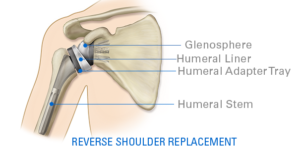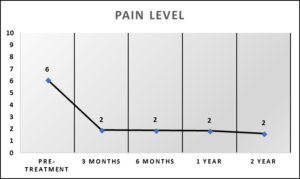Reverse Total Shoulder Replacement Outcomes
Proven results from reverse total shoulder arthroplasty performed by Dr. Gobezie, restoring function for patients with severe rotator cuff damage
Reverse total shoulder replacement (RTSR) is a specialized surgical procedure designed for patients whose rotator cuff is too damaged to support a traditional shoulder replacement. At the Cleveland Shoulder Institute, Dr. Gobezie has performed hundreds of reverse shoulder replacements, achieving consistently excellent outcomes for patients who were previously considered poor surgical candidates.
Our patient outcome data demonstrates significant improvements in both pain relief and functional capacity. Patients typically experience marked improvement within the first three months after surgery, with continued gains through the one and two-year post-operative milestones.

What Is Reverse Total Shoulder Replacement?
Reverse total shoulder replacement is an innovative variation of shoulder joint replacement surgery in which the normal ball-and-socket anatomy of the shoulder is "reversed." The ball component (glenosphere) is placed where the socket (glenoid) would normally be, and the socket component is placed on the humeral side. This unique design fundamentally changes the biomechanics of the shoulder, allowing the larger deltoid muscle to take over the work that the damaged rotator cuff can no longer perform.
The procedure was first developed in Europe in the 1980s and has since become the preferred treatment for patients with rotator cuff tear arthropathy—a condition where severe rotator cuff damage leads to shoulder arthritis. According to the Journal of Shoulder and Elbow Surgery, reverse shoulder replacement has revolutionized treatment options for patients who would have had limited alternatives just two decades ago.
Indications for Reverse Total Shoulder Replacement
- Painful rotator cuff tear arthropathy (combined massive rotator cuff tear with arthritis)
- Failed fracture repair with loss of rotator cuff function
- Failed prior shoulder replacement surgery (revision cases)
- Massive irreparable rotator cuff tears with pseudoparalysis
- Complex proximal humerus fractures in older patients
- Tumor reconstruction of the proximal humerus
The reverse design is particularly beneficial for older patients (typically 65 and above) who have exhausted conservative treatment options and require a solution that doesn't rely on rotator cuff function for stability and movement.
How the Reverse Design Works
In a normal shoulder, the rotator cuff muscles are essential for lifting and rotating the arm. When these muscles are severely torn or degenerated, a traditional shoulder replacement cannot restore function because the rotator cuff is still needed to move the arm. The reverse total shoulder replacement solves this problem by changing the mechanics of the joint entirely.
By placing the ball on the glenoid (socket) side and the socket on the humeral (arm) side, the center of rotation is moved medially and inferiorly. This repositioning allows the deltoid muscle—a large, powerful muscle on the outside of the shoulder—to take over the lifting function that the rotator cuff can no longer perform. The result is that patients can raise their arm overhead, often for the first time in years.
The reverse design provides several key benefits:
- Allows arm elevation without functional rotator cuff
- Provides a stable, fixed fulcrum for the deltoid to work against
- Reduces pain by eliminating bone-on-bone contact
- Restores the ability to perform overhead activities
For detailed information about the surgical technique and post-operative care, download our surgical details packet (PDF).
Evidence-Based Outcome Tracking
Dr. Gobezie is committed to measuring and improving patient outcomes through systematic data collection. Unlike many practices, the Cleveland Shoulder Institute tracks every patient's progress using validated, standardized questionnaires before surgery and at regular intervals afterward. This evidence-based approach allows us to quantify results and continuously refine our techniques.
We use three primary outcome measures to assess patient progress:
- Pain Scale (0-10): Patients rate their pain intensity from 0 (no pain) to 10 (worst imaginable pain)
- SANE Score: Single Assessment Numeric Evaluation—patients rate their shoulder as a percentage of normal (0% to 100%)
- ASES Score: American Shoulder and Elbow Surgeons standardized score measuring pain and functional limitations on a 100-point scale
Research from the National Library of Medicine consistently demonstrates that surgeons who perform higher volumes of specific procedures achieve better patient outcomes. Dr. Gobezie performs more than 350 shoulder replacements and 400 arthroscopic shoulder procedures annually, making him one of the highest-volume shoulder specialists in the country. His extensive experience with reverse shoulder replacement spans hundreds of cases, providing patients with the confidence that comes from choosing a surgeon at the top of his field.
Our Reverse Total Shoulder Replacement Results
The following data represents outcomes from patients treated at the Cleveland Shoulder Institute who underwent reverse total shoulder arthroplasty. These results demonstrate significant, sustained improvements in both pain and function for patients who often had severely limited mobility before surgery.
(out of 10)
(% of Normal)
(out of 100)
Pain Level Over Time

Pain scores indicate the patients' level of pain from pre-surgery through two years after surgery. All graphs show marked improvement in pain and function in the first 3 months after surgery. These outcomes continue to improve through one and two-year post-surgery milestones.
SANE Score (Shoulder Function)

The SANE score represents how patients rate their shoulder as a percentage of normal, from 0% to 100% with 100% being completely normal function. Our patients improve from an average of 31% to 73% of normal function—more than doubling their perceived shoulder capability.
ASES Score (Pain & Function)

The ASES score is a standard shoulder assessment that measures pain and functional limitations of daily activities on a 100-point scale. A maximum ASES score of 100 indicates minimal shoulder pain and maximal shoulder function. Our patients improve from an average of 34 to 77, representing a substantial gain in quality of life.
What These Results Mean for You
The outcome data from our practice demonstrates above-average patient-reported results in both pain relief and functional improvement. Patients who undergo reverse total shoulder replacement at the Cleveland Shoulder Institute can expect:
- Significant pain reduction—from severe (6/10) to mild (2/10) within months
- More than doubled functional capacity as measured by SANE scores
- Ability to raise the arm overhead, often for the first time in years
- Return to activities of daily living with improved independence
- Continued improvement through one and two years post-surgery
Dr. Gobezie's high surgical volume translates to refined technique, fewer complications, and better value-based care—meaning better outcomes at competitive cost. His extensive experience with complex shoulder cases, including revisions and tumor reconstruction, gives patients confidence that even challenging cases will be handled with expertise.
Is Reverse Shoulder Replacement Right for You?
If you have a massive rotator cuff tear with arthritis or a failed prior shoulder surgery, schedule a consultation with Dr. Gobezie to discuss whether reverse total shoulder replacement can restore your function and relieve your pain.
Schedule Consultation